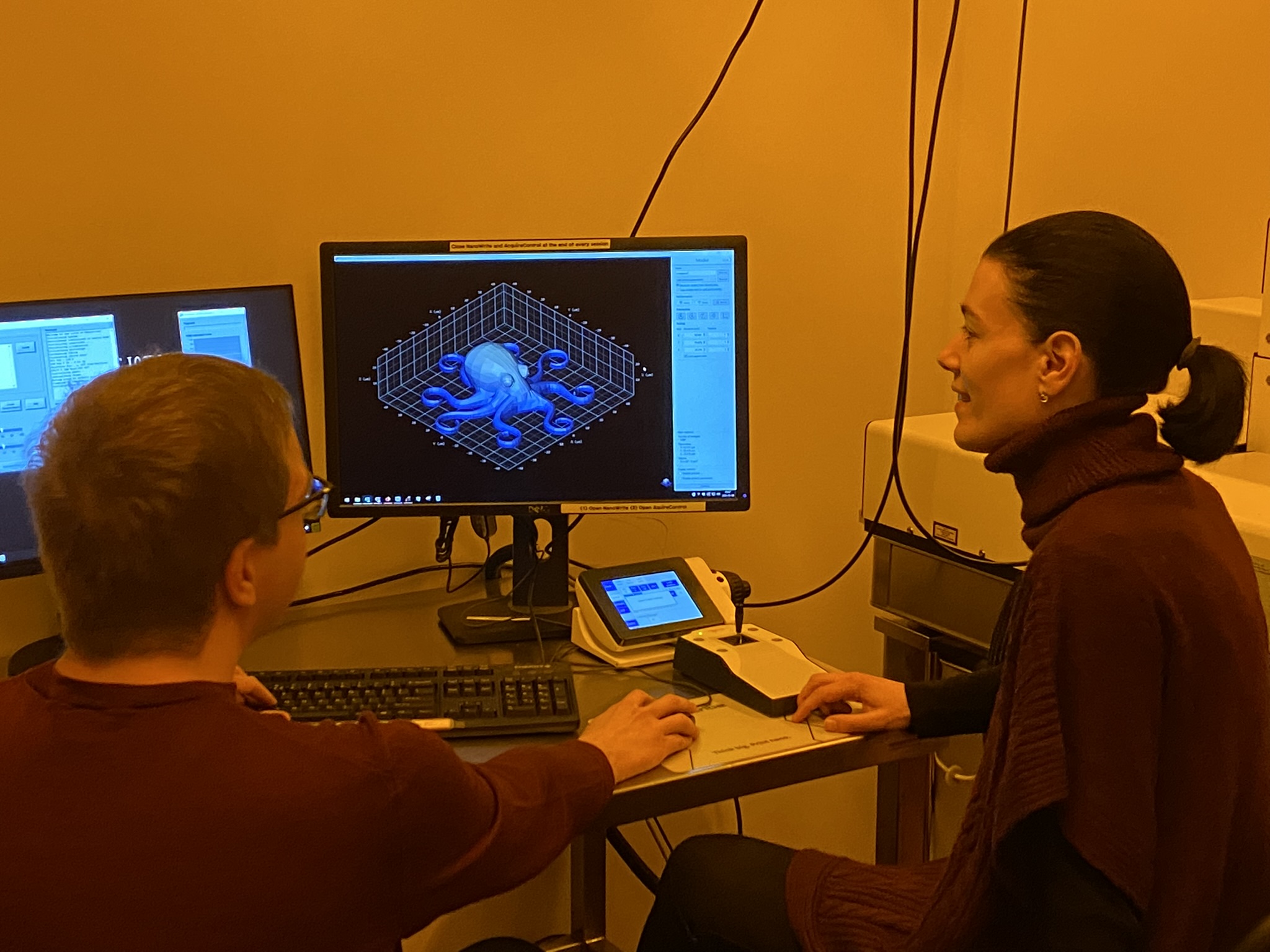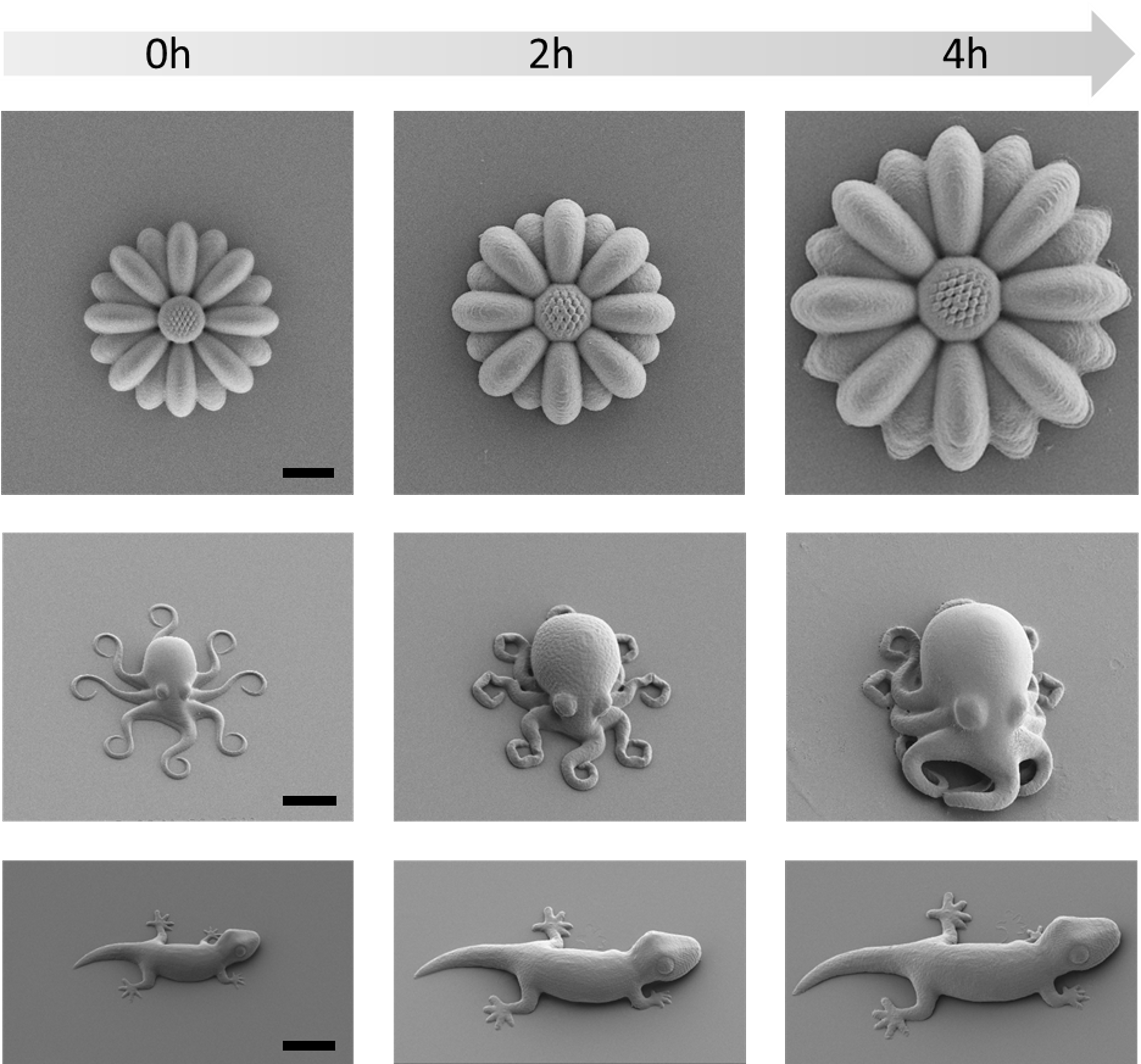"Programmable" polymer materials
Medicine of the future: intelligent 4D polymers from the printer
These days, it is impossible to imagine medicine without 3D printing, which can be used to make implants or for culturing cells and tissues, for example. It is now possible for three-dimensional objects to be given an added dimension, namely an ability to make simple autonomous movements, by changing their size. Researchers at Heidelberg University have been able to produce microscopically small 4D structures from intelligent polymers that can be tailored to individual requirements.
Micrometre-sized sunflowers, octopuses or geckos with ‘lifelike’ properties and tiny boxes that open and close by themselves can all be created artificially by 3D printers. What sounds almost unimaginable and can only be seen through a microscope has actually been developed by researchers at the University of Heidelberg and the Karlsruhe Institute of Technology (KIT) as part of the 3D Matter Made to Order (3DMM2O) cluster of excellence. Novel materials - intelligent polymers - were developed for the printed microstructures, which give the objects a fourth dimension. In addition, and depending on the application, they can be produced within a short time and with the highest precision when activated with light.
The project was led by chemists headed up by Professor Dr. Eva Blasco from the Institute for Molecular Systems Engineering and Advanced Materials at Heidelberg University, who have been working on the development of materials for 3D printing for a long time. "Standard materials almost always result in a static object," explains Blasco. "But we wanted to give these objects new properties that would stimulate the creation of biomedicine or microrobotics applications. To do this, we took inspiration from nature and came up with stimuli-responsive materials that grow in size in a way similar to their natural models but which can also change their mechanical properties."
The fourth dimension gives ‘lifelike’ properties
 Prof. Dr. Eva Blasco and Christoph Spiegel have developed microscopically small animals with 3D printers. Conceivable future applications are diverse and also have the potential for a whole range of medical applications. © University of Heidelberg
Prof. Dr. Eva Blasco and Christoph Spiegel have developed microscopically small animals with 3D printers. Conceivable future applications are diverse and also have the potential for a whole range of medical applications. © University of HeidelbergThe printing of three-dimensional objects was invented around 40 years ago and has spread rapidly in the most diverse areas of application, especially in recent years. 3D printers have since even become available for domestic use, and there are numerous methods and materials to create products of varying levels of sophistication. What they all have in common is the principle of printing, in which a model is first constructed on the computer and then the ‘ink’ is applied in the printer layer by layer countless times in succession until the required three-dimensional object has been created. Depending on the process, the starting material is cured with the help of light, for example.
3D printing has long been part of everyday routines in some areas of medicine and the life sciences - especially when components such as implants have to be manufactured to individual requirements. But there are even more innovations: for a few years now, it has also been possible to give 3D objects a fourth dimension - namely time. This means that they can change as a result of certain environmental stimuli, e.g. an increase in temperature. Such ‘intelligent’ materials have ‘lifelike’ properties because they can change on their own. Early-stage applications already exist, e.g. as self-adjusting orthoses or biological hearing aids.
Printable in the macro- and microscale for the first time
However, these developments in the life sciences have so far only been successful on the macroscale. Until now, that is, because last year the 3DMM2O researchers from Heidelberg designed a shape memory polymer system that is printable on both the macro- and microlevels1). They also successfully developed 3D-printed polymer materials with programmable properties on the microscale.2) The result was programmable microarchitectures from the plant and animal kingdoms that mimic natural models. "The mini objects - such as an octopus - were able to grow to many times their volume and harden in just a few hours using the simplest chemical modification processes," reports Christoph Spiegel, a doctoral student in the research group. "This is of particular interest for bioapplications, as the material can be programmed, and its properties adjusted as required."
 Intelligent polymers give 3D-printed microstructures ‘lifelike’ properties. They can grow eightfold in size within a few hours, and harden. Shape and structural elements remain intact. © University of Heidelberg
Intelligent polymers give 3D-printed microstructures ‘lifelike’ properties. They can grow eightfold in size within a few hours, and harden. Shape and structural elements remain intact. © University of HeidelbergAs regards this type of 4D printing on the microscale, the additional dimension to 3D printed objects refers to their ability to change their properties over time, a process in which the intelligent polymers react to the external stimulus of temperature. "The structures are completely stable at room temperature," says Blasco. "They are only activated when exposed to heat. Other materials can be better activated by exposure to light, for example. For a biomedical application, activation with infrared light would be conceivable in the future, for example."
The magic of the process developed in Heidelberg is not the printing method, but the ‘ink’, as the professor calls it: "Although our speciality is printing with light, we have not changed anything in this regard compared to conventional processes. Instead, we have introduced ‘dormant groups’ - alkoxyamines - that can be activated with a change in temperature. These dynamic groups are the heart of the 'living' properties of our polymers, and the principle behind the development." "The material itself is made of soft, biocompatible polyethylene glycol, post-modified with polystyrene for contrast," she adds. "Through this, the objects grow up to eight times their size. Their shape and structural elements remain intact."
Stents and self-healing tissues made from intelligent polymers
In the case of microprinted shape memory polymers, the conceivable areas of application are equally large because the process is extraordinarily flexible: by choosing the particular material, starting quantity, model and process for printing, as well as the appropriate functionalities for the desired stimulus, highly specific shape memory polymers can be created. "It would be conceivable, for example, to produce small stents that are pushed through the vessels before opening by themselves," says Blasco, "or we could print self-healing tissue." The field of tissue engineering is currently completely passive. With our microstructures, tissue could grow and adapt, much like in real life. A completely different application potential also lies in microrobotics, where objects that move by themselves are needed. Microfluidics would be another great field - we have experimented with a box that opens by itself."
The two researchers emphasise that such concrete applications are unfortunately still a long way off. Nevertheless, industry has already signalled interest in cooperations. Blasco and her team are now planning experiments with other materials: "Our focus here is on the possibility of stimulating objects with light," says the expert. "Even completely different functionalities are conceivable, such as complete biocompatibility or the implementation of self-reporting or self-regulating properties that are present in natural systems, for example. We have a lot of ideas."